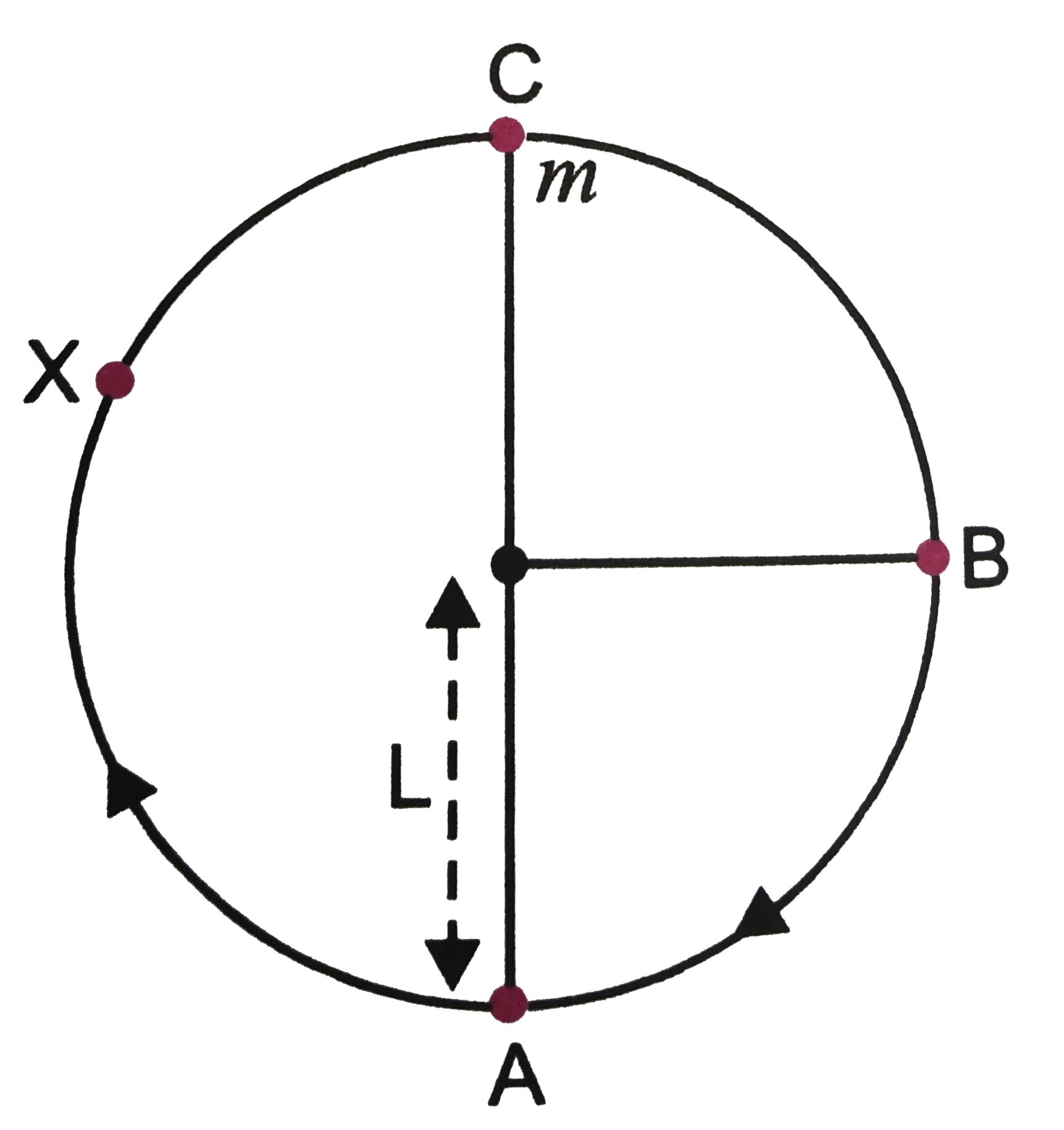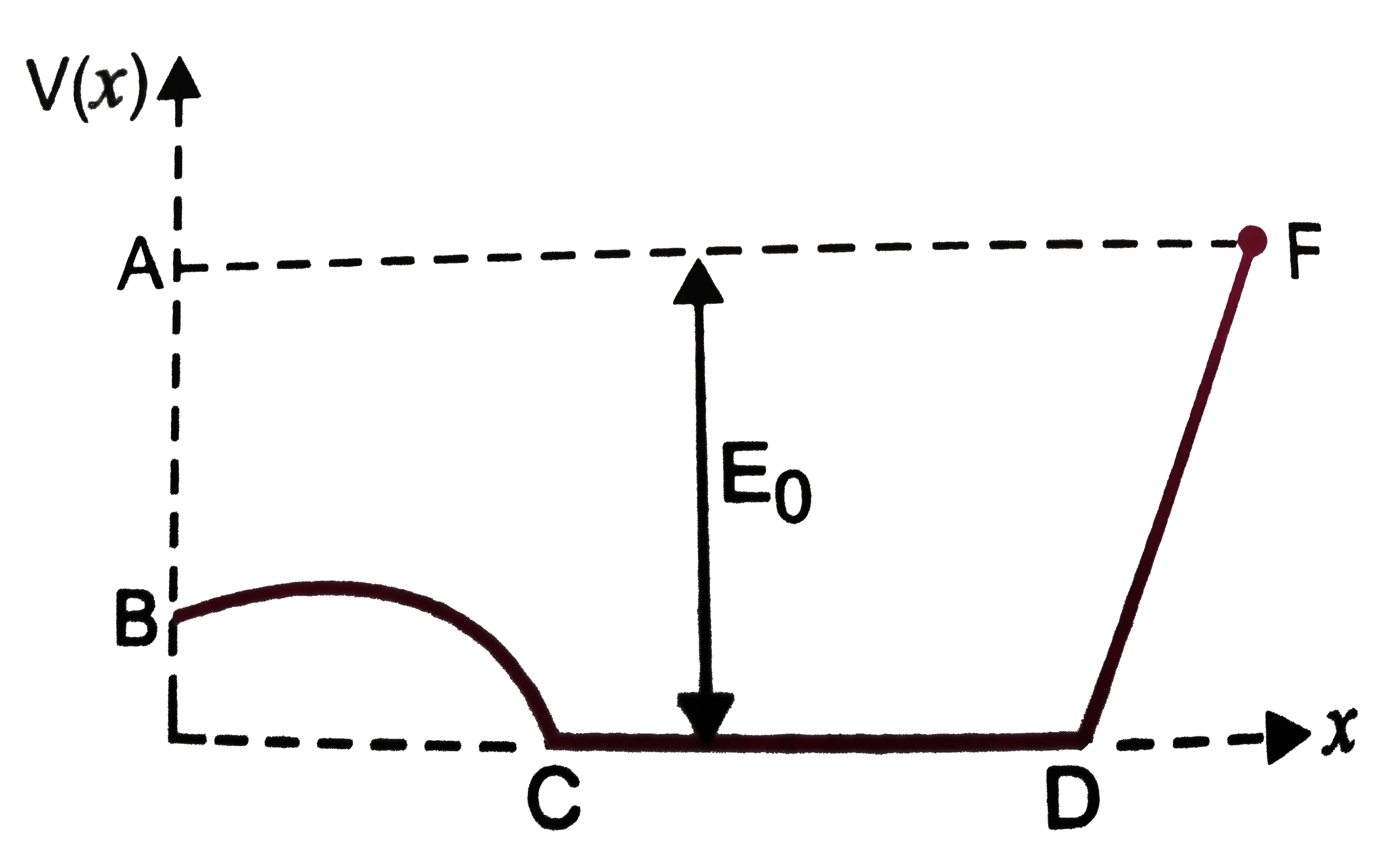NCERT FILE (Exemplar Problems Objective Questions) from MODERN PUBLISHERS PHYSICS (HINGLISH) WORK, ENERGY AND POWER for Class 11
| Class 11 | PHYSICS |
| Chapter | WORK, ENERGY AND POWER |
| MODERN PUBLISHERS PHYSICS (HINGLISH) | NCERT FILE (Exemplar Problems Objective Questions) |
| Medium | English |
| Academic Year | 2023-2024 |
Question 1
The sign of work done by a force is important to understant. State carefully if the following quantities are positive or negative. (a) Work done by a man in lifting a bucket out of a well by means of a rope tied to the bucket. (b) Work done by the gravitational force in the above case. (c ) Work done by friction on a body sliding down an inclined plane. (d) Work done by an applied froce on a body moving on a rough horizontal plane with uniform velocity. (e ) Work done by the resistive force of air on a vibrating pendulum in bringing it to rest.View SolutionQuestion 2
A body of mass 2 kg initially at rest moves under the action of an applied horizontal force of 7N on a table with coefficient of kinetic friction =0.1. Calculate the
(a) work done by applied force in 10s. (b) work done by friction in 10s.
(c ) work done by the net force on the body in 10s.
(d) change in K.E. of body in 10s, and interpret your result. View SolutionQuestion 3
Given in fig are examples of some potential energy functions in one dimension. The total enrgy of the particle is indicated by a cross on the ordinate axis. In each case, specify the regions, if any, in which the particle cannot be found for the given energy. Also, indicate the minimum total energy the particle must have in each case. Think of simple physical contexts for which these potential energy shapes are relevant.
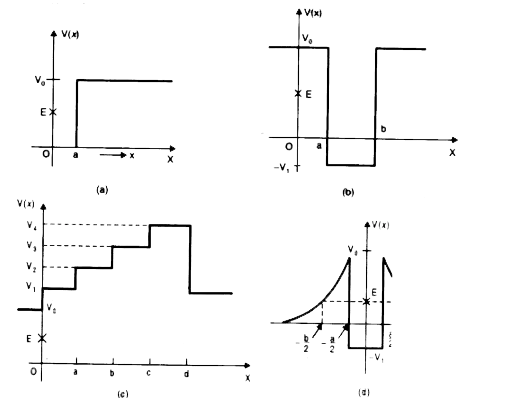 View Solution
View SolutionQuestion 5
Answer the following:
a) The casing of a rocket in flight burns up due to friction. At whose expense is the heat required for burning obtained? The rocket or the atmosphere?
b) Comets move around the sun in highly elliptical orbits. The gravitational force on the comet due to the sun is not normal to the comet's velocity in general. Yet the work done by the gravitatonal force over every complete orbit of the comet is zero. Why?
c) An artificial satellite orbiting the earth in very atmosphere loses its energy grdually due to dissipation against atmospheric resistance, howerver small. Why then does its speed increase progressively as it comes closer and closer tothe earth? d)In fig i) the man walks 2m carrying a mass of 15 kg on his hands. In Fig ii) he walks the same distance pulling the rope behind him. The rope goes over pulley, and a mass of 15 kg hangs at its other end. In which case is the work done greater?
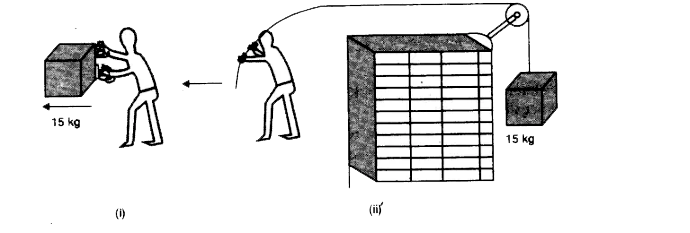 View Solution
View SolutionQuestion 6
Underline the correct alterntaive:
a) when a conservative force does positivie work on a body, the potential energy of the body increase/decreases/remains unaltered.
work done by a body against friction always results in a loss of its kinetic /potential energy.
c) The rate of change of total momentum of a many-particle system is proportional to the external force/ sum of the internal forces on the system.
d) In an inelastic collision of two bodies, the quantities which do not change after the collision are the total kinetic energy/total linear momentum/total enregy of the system of two bodies. View SolutionQuestion 7
State if each of the following statements is true or false. Give reasons for your answer.
a) In an elastic collision of two bodies, the momentum and energy of each body is conserved.
b)Total energy of a systm is always conserved,no matter what internal and external forces on the body are present.
Work done in the motion of a body over a closed loop is zero for every force in nature.
d) In an inelastic collision, the final kinetic energy is always less than the initial kinetic energy of the sytem. View SolutionQuestion 8
Anwer carefully, with reasons:
a) In an elastic collision of two billiard balls, is the total kinetic energy conserved during the short time of collision of the balls (i.e. when they are in contact)?
Is the total linear momentum conserved during the short time of an elastic collision of two balls?
c) What are the answers to a) and b) for an inelastic collision?
d) If the potenital energy of two billiard balls depends only on the separation distance between their centers, is the collision elastic or inelastic? (note we are talking here of potential energy corresponding to the force during collision, not gravitational potential energy).View SolutionQuestion 11
A body constrained to move along the z-axis of a co-ordinate system, is subjected to a constant force →F given by →F=−ˆi+2ˆj+3ˆk Newton where ˆi,ˆjand ˆk represent unit vectors along x-,y-,and z-axes of the system, respectively. Calculate the work done by this force in displacing the body through a distance of 4m along the z-axis.View SolutionQuestion 12
An electron and a proton are detected in a cosmic ray experiment, the first with kinetic energy 10 keV, and the second with 100 keV. Which is faster, the electron or the proton ? Obtain the ratio of their speeds.
(Electron mass =9.11×10−31kg, proton mass =1.67×10−27kg,1eV=1.60×10−19J).View SolutionQuestion 13
A rain drop of radius 2mm, falls from a height of 500 m above the ground. It falls with decreasing acceleration due to viscous resistance of air until half its original height. It attains its maximum (terminal ) speed, and moves with uniform speed there after. What is the work done by the gravitational force on the drop in the first half and second half of its journey ? Take density of water =103kg/m3. What is the work done by the resistive force in the entire journey if its speed on reaching the ground is 10ms−1 ?View SolutionQuestion 16
Two identical ball bearings in contact with each other and resting on a frictionless table are hit head on by another ball bearing of the same mass moving initially with a speed v, figure,. If the collision is elastic, which of the following is a possible result after collisioin?
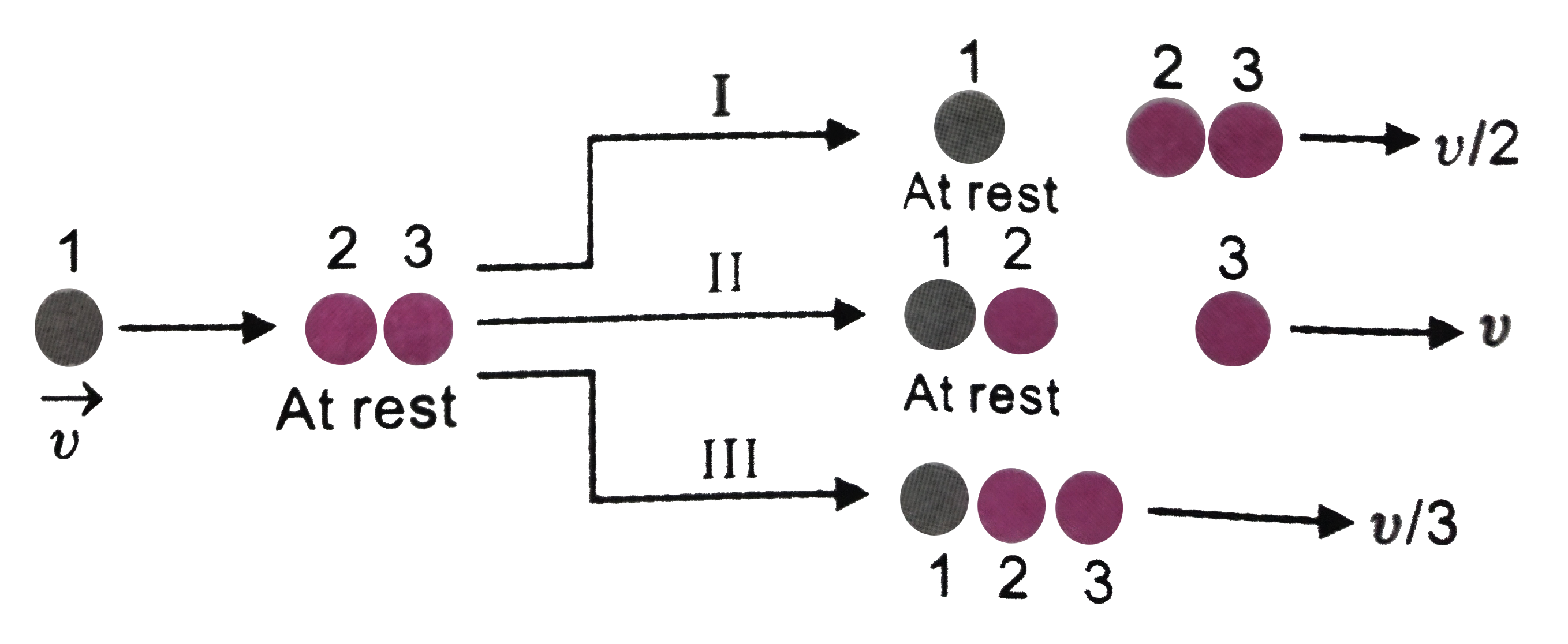 View Solution
View SolutionQuestion 18
The bob A of a simple pendulum is released from a horizontal position A as shownin in figure. If the length of the pendulum is 1.5m , what is the speed with which the bob arrives at the lowermost point B, given that it dissipates 5% of its initial energy against air resistance ?
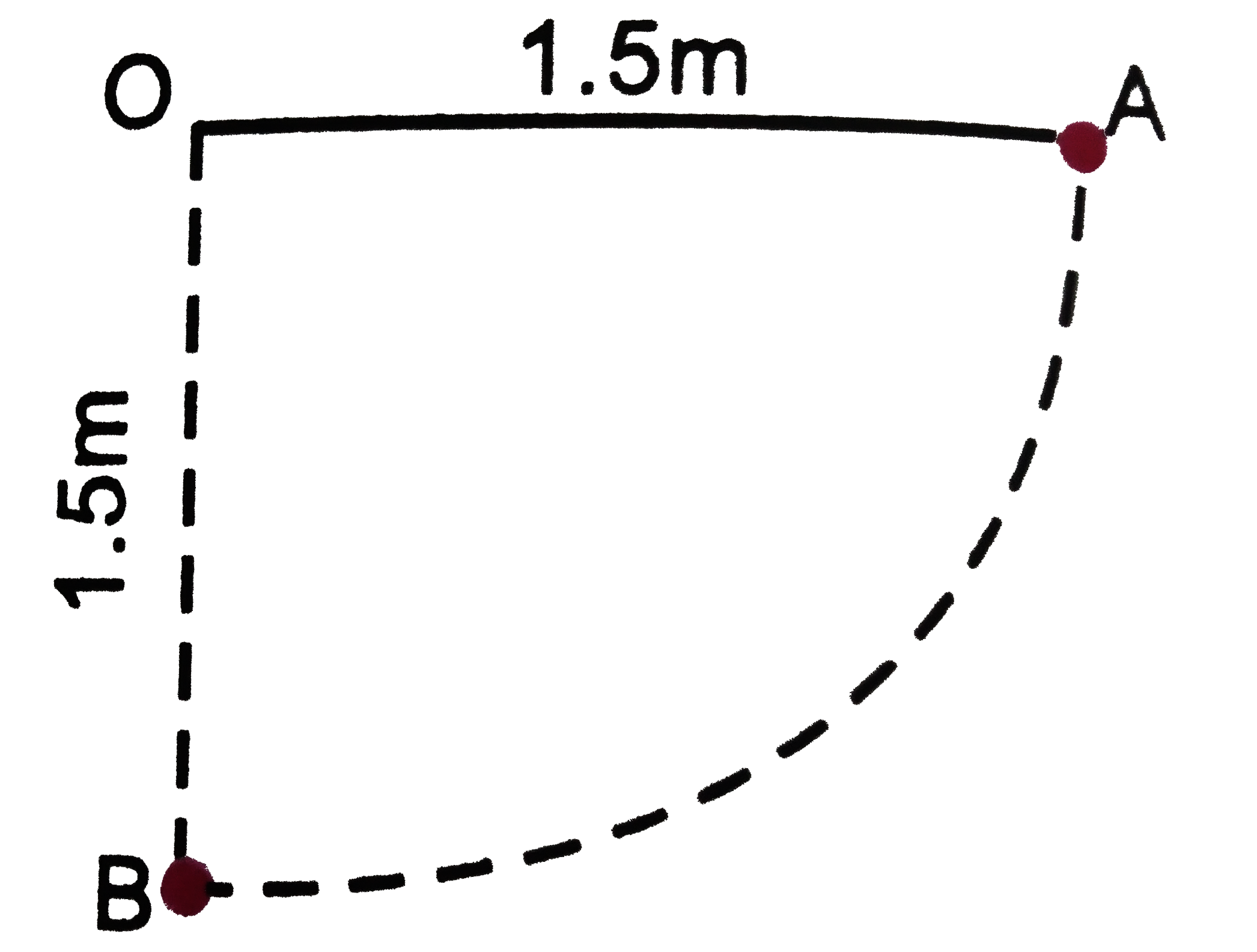 View Solution
View SolutionQuestion 19
A trolley of mass 300 ks carrying a sand bag of 25 kg is moving uniformly with a speed of 27km/h on a frictionless track. After a while, sand starts leaking out of a hole on the trolley's floor at the rate of 0.05kgs−1. What is the speed of the trolley after the entire sand bag is empty ?View SolutionQuestion 21
The blades of a windmill sweep out a circle of area A. (a) If the wind flows at a velocity v perpendicular to the circle, what is the mass of the air passing through in time t? (b) What is the kinetic energy of the air? (c) Assume that the windmill converts 25% of the wind's energy into electrical energy, and that A=30m2, v=36kmh−1 and the density of air is 1.2kgm−3, what is the electrical power produced?View SolutionQuestion 22
A person trying to lose weight (dieter ) lifts a 10 kg mass through 0.5m, 1000 times, A ssume that the potential energy lost each time she lowers the mass is dissipated (a) How much work does she does against the gravitational force ? (b) Fat supplies 3.8×107J of energy per kilogram which is converted to mechanical energy with a 20% efficiency rate. How much fat will the dieter use up ?View SolutionQuestion 23
A family uses 8kW of power. (a) Direct solar energy is incident on the horizontal surface at an average rate of 200 W per square metre. If 20% of this energy can be converted to useful electrical energy, how large an area is needed to supply 8kW? (a) Compare this area to that of the roof of a typical house. View SolutionQuestion 24
A bullet of mass 0.012 kg and horizontal speed 70ms−1 strikes a block of wood of mass 0.4 kg and instantly comes to rest with respect to the block. The block is suspended from the ceiling by thin wire. Calculate the height to which the block rises. Also, estimate the amount of heat produced in the block. View SolutionQuestion 25
Two inclined frictionless tracks, one gradual and the other steep meet at A from where to stones are allowed to slide down from rest, one on each track (fig.) Will hte stones reach the bottom at the same time? Will they reach there with the same speed? Explain, given θ1=30∘, θ92)=60∘ and h=10m. What are the speeds and time taken by the two stones?
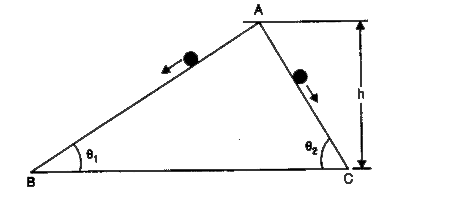 View Solution
View SolutionQuestion 26
A 1kg block situated on a rough incline is connected to a spring of spring constant 100Nm−1 as shown in figure,. The block is released from rest with the spring in the unstretched position. The block moves 10cm down the incline before coming to rest. Find the coefficient of friction between the block and the incline. Assume that the spring has negligible mass and the pulley is frictionless.
 View Solution
View SolutionQuestion 27
A bob of mass 0.3 kg falls from the ceiling of an elevator moving down with a uniform speed of 7ms−1. If hits the floor of the elevator (length of the elevator = 3m) and does not rebound. What is the heat produced by the impact ? Would your answer be different if the elevator were stationary ?View SolutionQuestion 28
A trolly of mass 200kg moves with a uniform speed of 36 km/h on a frictionless track. A child of mass 20kg runs on the trolly from one end to the other (10m away) with a speed of 4m/s relative to the trolly in a direction opposite to the trolly's motion and jumps out of the trolly. How much has teh trolly moved from the time the child begins to run ?View SolutionQuestion 30
Consider the decay of a free neutron at rest :
n→p+e−
Show that the two - body decay of this type must necessarily give an electron of fixed energy and therefore , cannot account for the observed continuous energy distribution in the β - decay of a neutron or a nucleus

[ Note : The simple result of this exercise was one among the several arguments advanced by W . Pauli to predict the existence of a third particle in the decay products of β - decay . This particle is known as neutrino . We know that it is a particle of intrinsic spin 12 (like e- , p or n ) , but is neutral , and either massless or having an extremely small mass ( compared to the mass of electron ) and which interacts very weakly with matter . The correct decay process of neutron is : n→p+e−+v .View SolutionQuestion 32
A proton is kept at rest. A positively charged particle is released from rest at a distance d in its field. Consider two experiments, one ini which the charged particle is also a proton and in another, a position. In the same time t, the work done on the two moving charged particles is View SolutionQuestion 38
The potential energy function for a particle executing linear SHM is given by V(x)=12kx2 where k is the force constant of the oscillator. For k=0.5Nm−1, the graph of V(x) versus x is shown in the figure A particle of total energy E turns back when it reaches x=±xm.if V and K indicate the potential energy and kinetic energy respectively of the particle at x=+xm,then which of the following is correct?
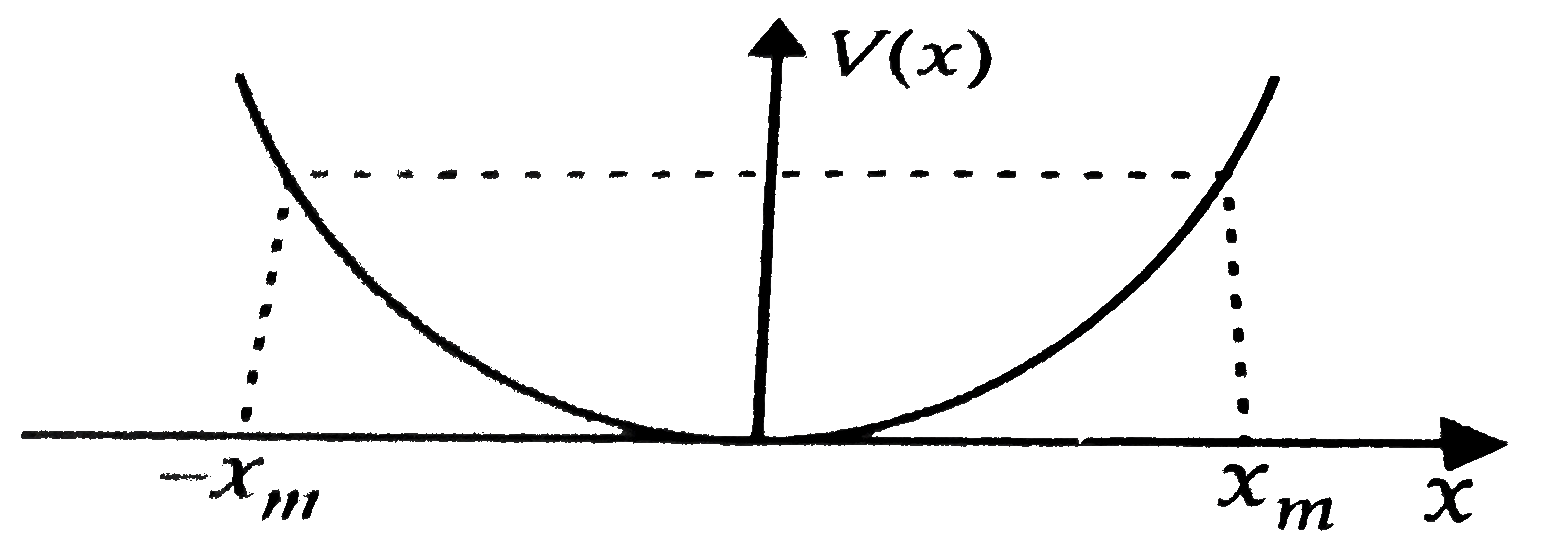 View Solution
View SolutionQuestion 39
Two identical ball bearings in contact with each other and resting on a frictionless table are hit heat-on by another ball bearing of the same mass moving initially with a speed V as shown in figure.
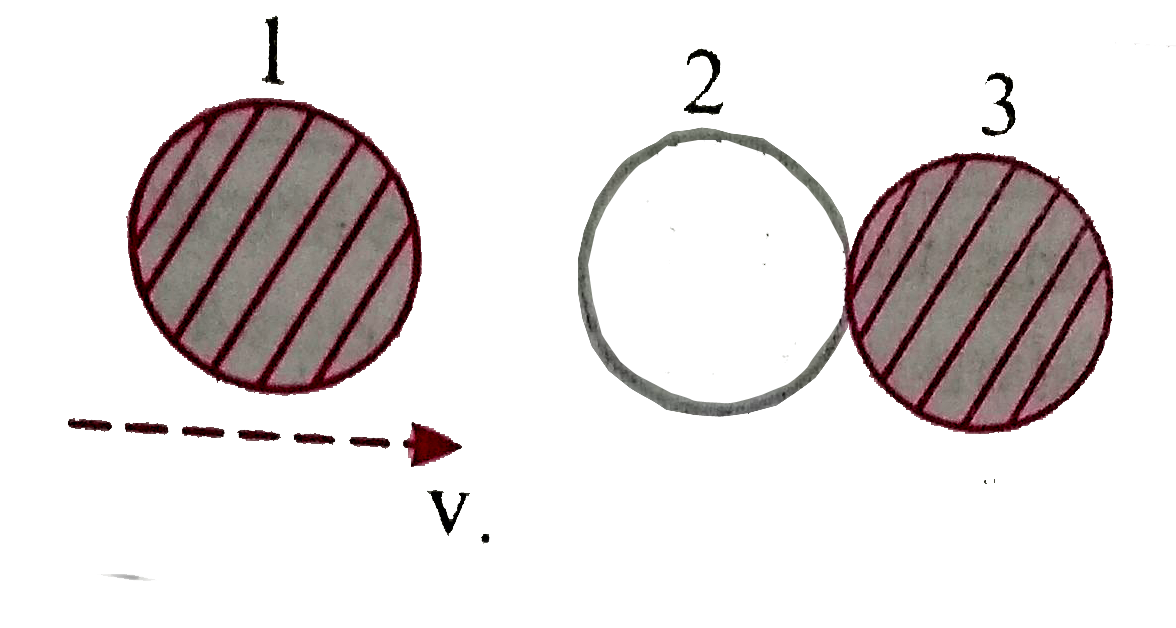
If the collision is elastic, which of the following (figure) is a possible result after collision ?View SolutionQuestion 46
In a shotput event an athlete throws the shotput of mass 10kgwith an initial speed of 1ms−1 at 45∘ from a height 1.5m above ground. Assuming air resistance to be negligible and acceleration due to gravity to be 10ms−2, the kinetic energy of the shotput when it just reaches the ground will beView SolutionQuestion 48
A cricket ball of mass 150g moving with a speed of 126km/h hits at the middle of the bat, held firmly at its position by the batman. The ball moves straight back to the bowler after hitting the bat. Assuming that collision between ball and bat is completely elastic and the two remain in contact for 0.001s, the force that the batsman had to apply to hold the bat firmly at its place would be View SolutionQuestion 50
A bullet of mass m fired at 30∘ to the horizontal leaves the barrel of the gun with a velocity υ. The bullet hits a soft target at a height h above the ground while it is moving downward and emerges out with half the kinetic energy it had before hitting the target.
Which of the following statements are correct in respect of bullet after it emerges out of the target ?View SolutionQuestion 66
Consider a one - dimensional motion a a particle with total energy E . There are four regions A,B,C and D in which the relation between potential energy V , kinetic energy (K) and total energy E is as given ahead :
State with reason in each case whether a particle can be found in the given region or not . View SolutionQuestion 67
The bob A of a pendulum released from horizontal to the vertical hits another bob B of the same mass at rest on a table as shown in figure.
If the length of the pendulum is 1m, calculate
(a) the height to which bob A will rise after collision.
(b) the speed with which bob B starts moving.
Neglect the size of the bobs and assume the collision to be elastic.
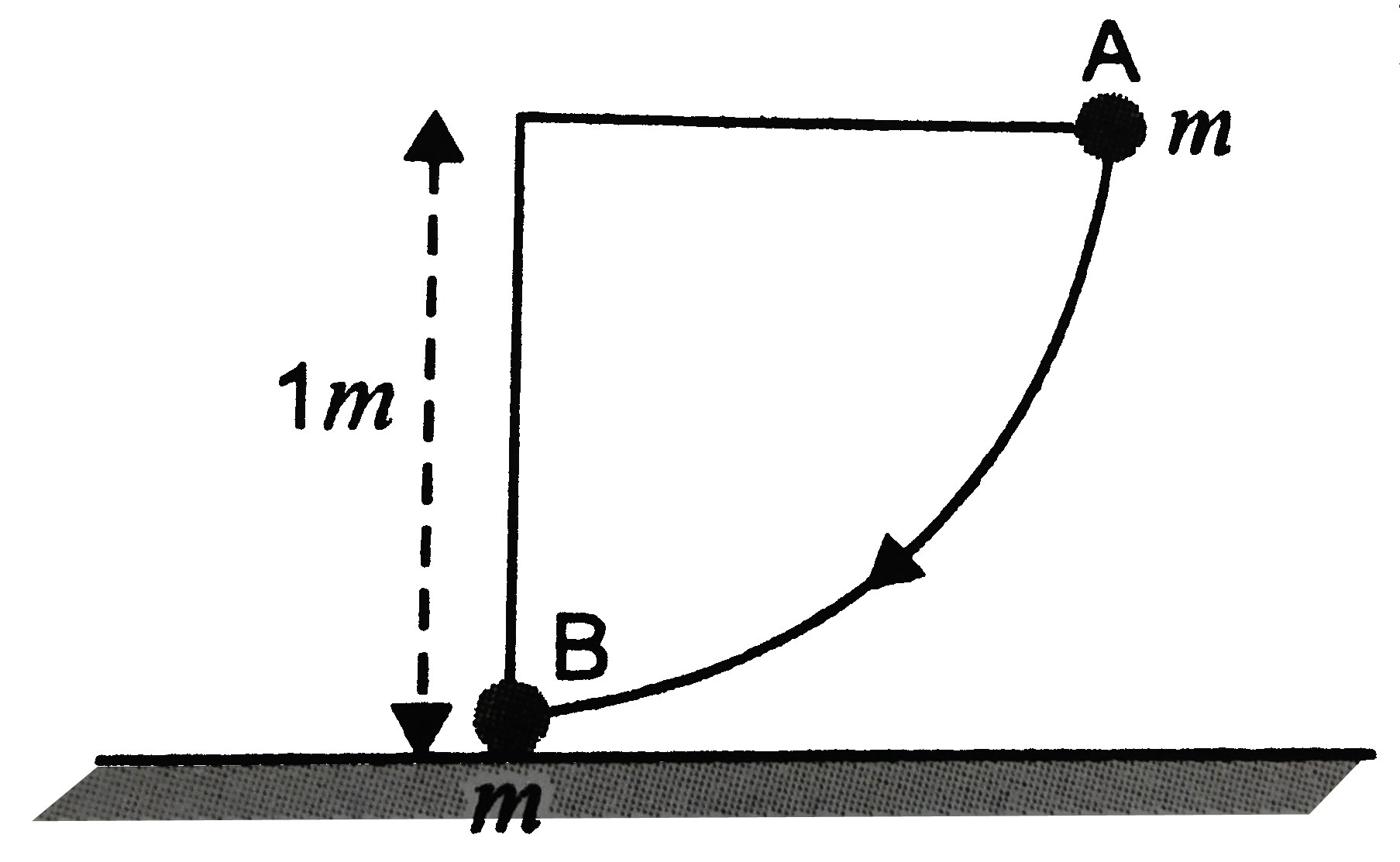 View Solution
View SolutionQuestion 69
Two pendulums with identical bobs and lengths are suspended from a common support such that in rest position, the two bobs are in constact, . One of the bobs is released after being displaced by 10∘ so that it collides elastically head - on with the other bob.
(a) Describe the motion of two bobs.
(b) Draw a graph showing variation in energy of either pendulum with time,for 0≤t≤2T , where T is the period of each pendulum.
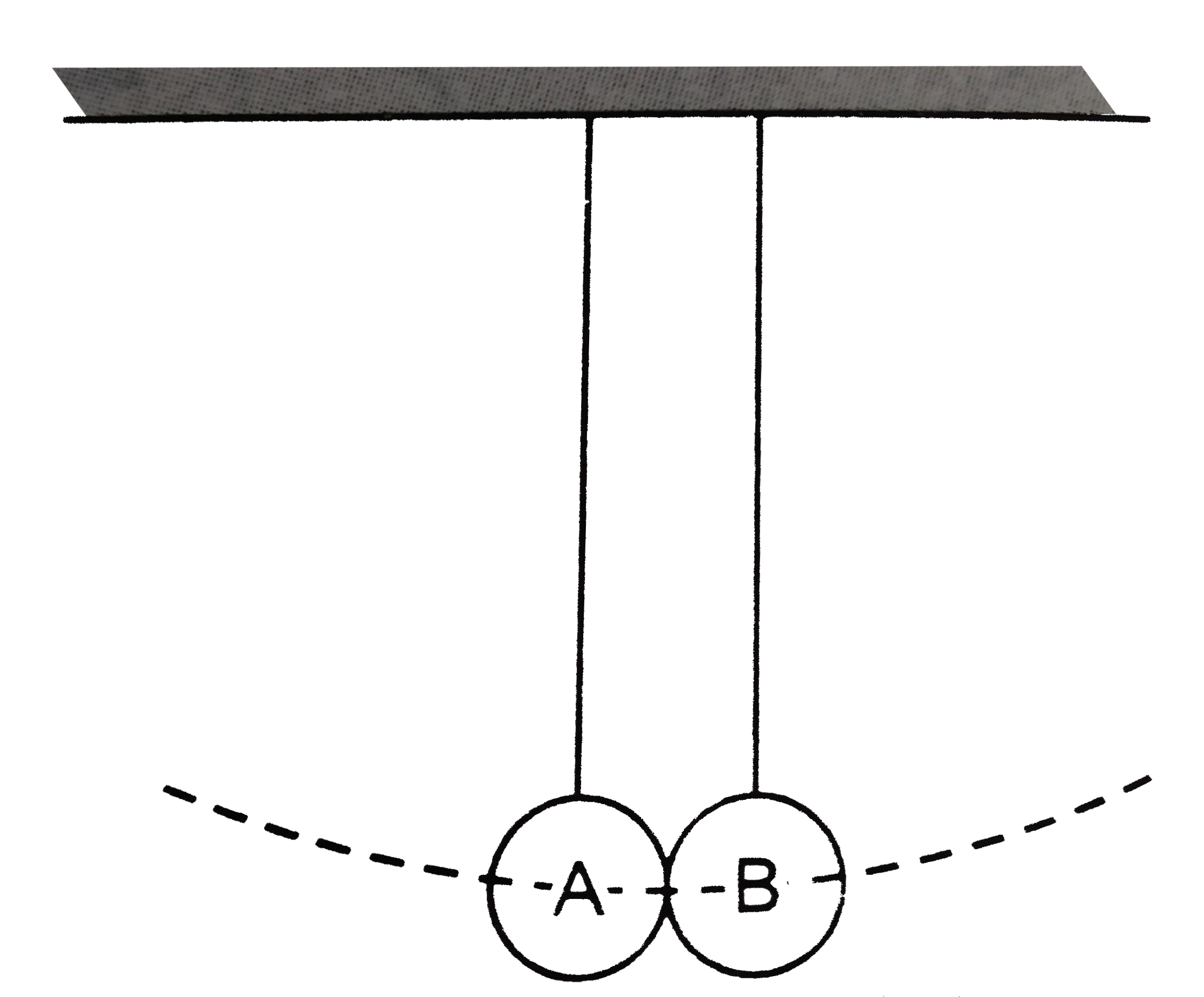 View Solution
View SolutionQuestion 71
An engine is attahed to a wagon through a shock absorber of length 1.5m. The system with a total mass of 50,000kg is moving with a speed of 36kmh−1 when the brakes are applied to bring it to rest. In the process of the system being brought to rest, the spring of the shock absorber gets compressed by 1.0m. If 90% of energy of the wagon is lost due to friction, calculate the spring constant. View SolutionQuestion 72
An adult weighing 600N raises the centre of gravity of his body by 0.25m while taking each step of 1m lenth in jogging. If he jogs for 6km, calculate the energy utilised by him in jogging assuming that there is no energy loss dur to friction of ground and air. Assuming that the body of the adult is capable of converting 10% of energy intake in the form of food, calculate the energy equivalent fo food that would be required to compensate energy utilised for jogging. View SolutionQuestion 73
On complete combustion , a litre of petrol gives off heat equivalent to 3×107J . In a test drive, a car weighing 1200kg, including the mass of driver, runs 15kg per litre while moving with a uniform speed on a straight track. Assuming that friction offered by the road surface and air to be uniform, calculate the force of friction acting on the car during the test drive. If the efficiency of the car engine were 0.5.View Solution
All Exercises from MODERN PUBLISHERS PHYSICS (HINGLISH) Class 11 PHYSICS WORK, ENERGY AND POWER
- PRACTICE PROBLEMS
- CONCEPTUAL QUESTIONS
- TOUGH & TRICKY (PROBLEMS)
- NCERT FILE (EXEMPLAR PROBLEMS OBJECTIVE QUESTIONS)
- NCERT FILE (NCERT ADDITIONAL EXERCISE)
- NCERT FILE (NCERT EXEMPLAR PROBLEMS (SHORT ANSWER TYPE QUESTIONS))
- NCERT FILE (NCERT EXEMPLAR PROBLEMS (VERY SHORT ANSWER TYPE QUESTIONS))
- NCERT FILE (NCERT TEXTBOOK EXERCISE)
- HIGHER ORDER THINKING SKILLS & ADVANCED LEVEL
- REVISION EXERCISE (ADDITIONAL QUESTIONS)
- REVISION EXERCISE (FILL IN THE BLANKS)
- REVISION EXERCISE (LONG ANSWER QUESTIONS)
- REVISION EXERCISE (NUMERICAL PROBLEMS)
- REVISION EXERCISE (SHORT ANSWER QUESTIONS)
- REVISION EXERCISE (VERY SHORT ANSWER QUESTIONS)
- OBJECTIVE TYPE QUESTIONS (A. MULTIPLE CHOICE QUESTIONS)
- OBJECTIVE TYPE QUESTIONS (ASSERTION REASON TYPE QUESTIONS)
- OBJECTIVE TYPE QUESTIONS (B. MULTIPLE CHOICE QUESTIONS)
- OBJECTIVE TYPE QUESTIONS (C. MULTIPLE CHOICE QUESTIONS)
- OBJECTIVE TYPE QUESTIONS (D. MULTIPLE CHOICE QUESTIONS)
- OBJECTIVE TYPE QUESTIONS (INTEGER TYPE QUESTIONS)
- OBJECTIVE TYPE QUESTIONS (JEE (ADVANCED) FOR IIT ENTRANCE)
- OBJECTIVE TYPE QUESTIONS (JEE (MAIN) & OTHER STATE BOARDS FOR ENGINEERING ENTRANCE)
- OBJECTIVE TYPE QUESTIONS (MATCHING TYPE QUESTIONS)
- OBJECTIVE TYPE QUESTIONS (MATRIX MATCH TYPE QUESTIONS)
- CHAPTER PRACTICE TEST
- SOLVED EXAMPLES
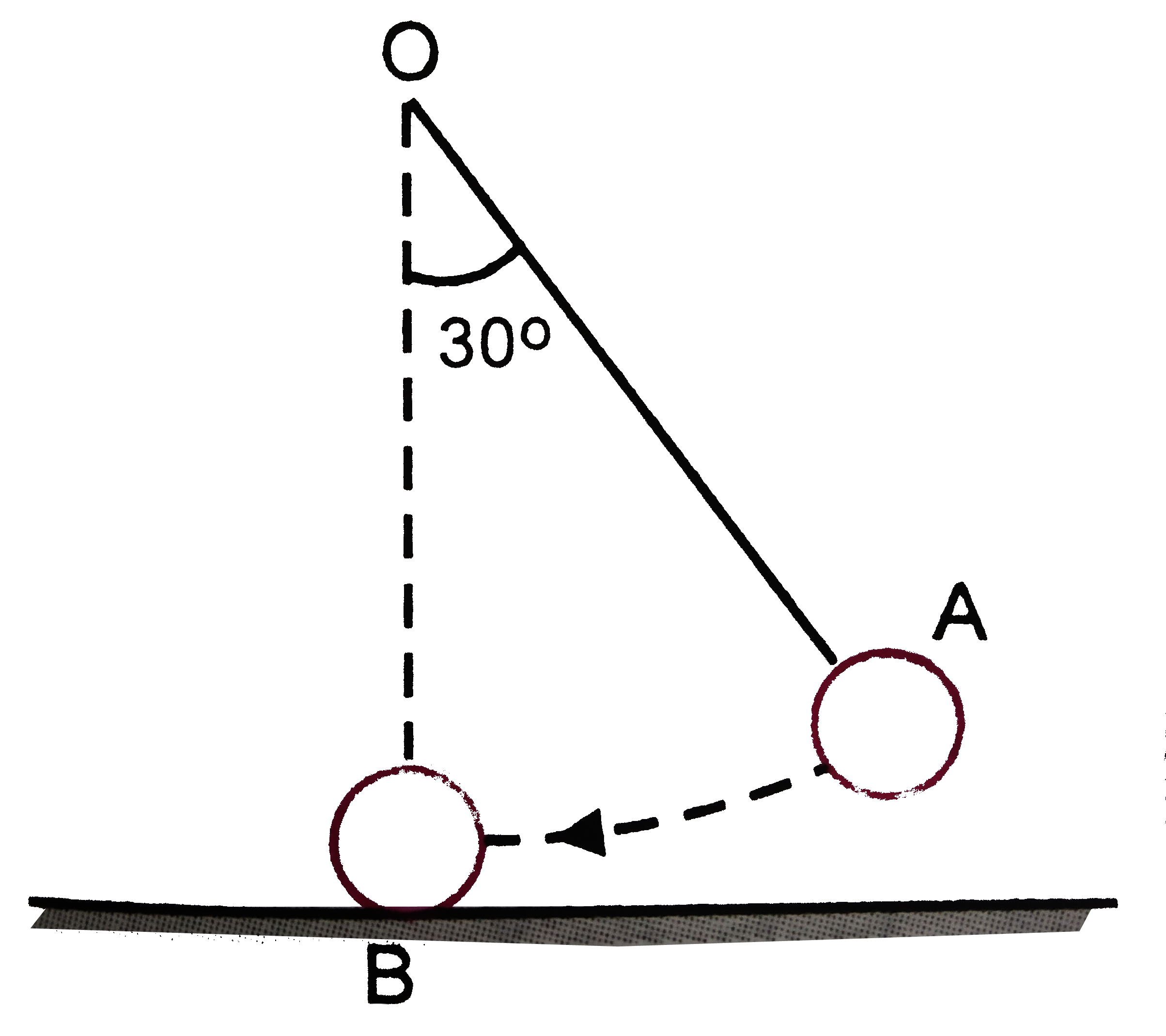


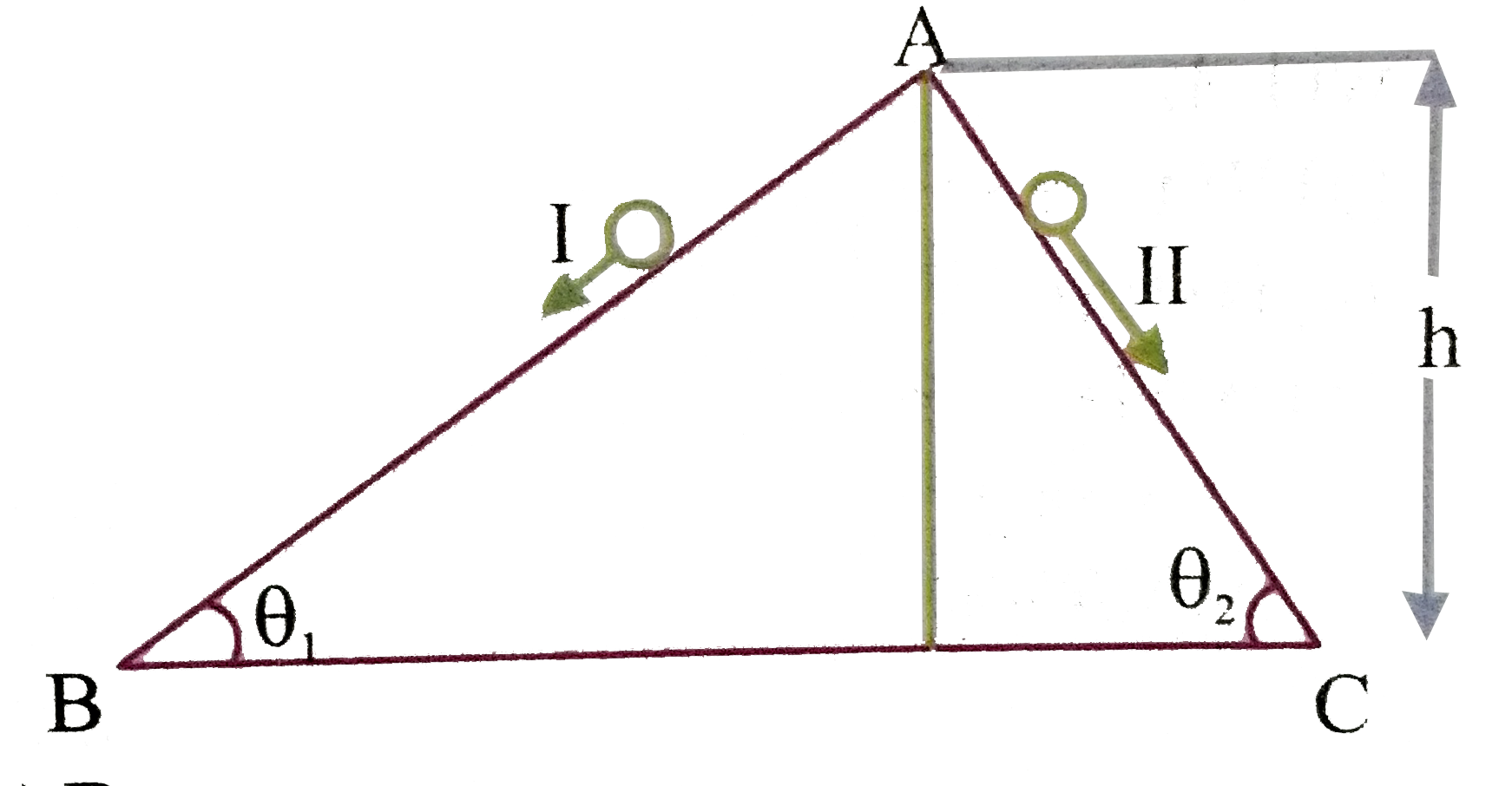 .
.
